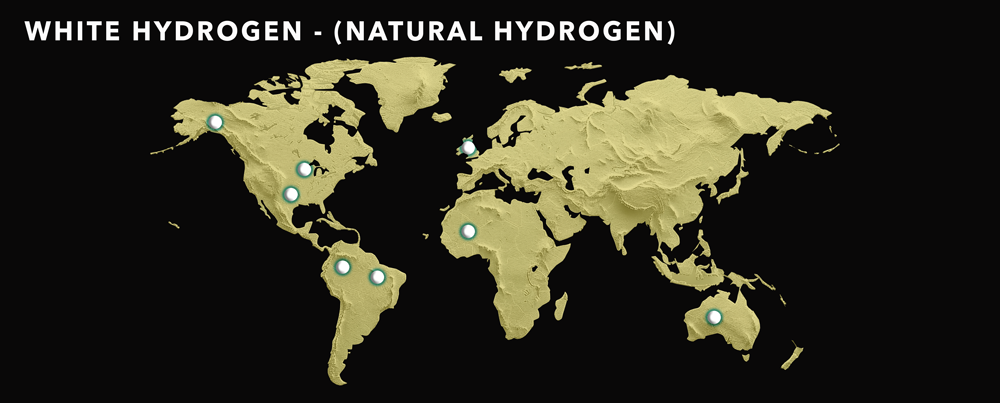
WHITE HYDROGEN - NATURALLY OCCURRING HYDROGEN
White hydrogen refers to naturally occurring hydrogen gas (H₂) found in the Earth's subsurface. Unlike most hydrogen, which is typically produced through industrial processes, white hydrogen exists in its molecular form as a free gas and is generated by natural geological processes. This type of hydrogen is distinct from other forms classified by production methods, such as grey, blue, or green hydrogen.
Naturally occurring hydrogen gas (H₂) is relatively rare on Earth compared to hydrogen bound in compounds like water (H₂O) and hydrocarbons. However, there are specific geological conditions and environments where hydrogen gas can be found naturally:
SUBSURFACE HYDROGEN DEPOSITS
- Description: Hydrogen gas can accumulate in subsurface geological formations, particularly in areas with specific geological conditions. These deposits are typically found in ultramafic rocks (rich in iron and magnesium), where water reacts with minerals like olivine through a process called serpentinization. This reaction produces hydrogen gas.
- Locations: Such hydrogen deposits have been found in places like continental rift zones, mid-ocean ridges, and certain areas with volcanic activity. There are also documented cases of natural hydrogen seeps on land, such as in Mali (the Bourakebougou site), Russia, and the United States (Kansas and Oklahoma).
VOLCANIC AND GEOTHERMAL REGIONS
- Description: Hydrogen gas can also be released in volcanic and geothermal regions due to the high-temperature reactions between water and rock, which produce hydrogen along with other gases.
- Locations: Volcanic gases and geothermal vents, such as those found in Iceland, New Zealand, and other tectonically active regions, sometimes contain hydrogen.
SERPENTINIZATION
- Description: This is a geological process where ultramafic rocks (containing minerals like olivine and pyroxene) react with water, producing hydrogen gas. This process is thought to be a significant source of natural hydrogen in the Earth's crust.
- Locations: Serpentinization occurs primarily in oceanic crust and along tectonic plate boundaries, but it can also occur in continental settings where ultramafic rocks are present.
HYDROGEN SEEPS
- Description: In some areas, hydrogen gas seeps naturally from the ground. These seeps can be a surface expression of deeper geological processes, such as serpentinization or the decay of organic matter.

ORIGINS AND SOURCES OF WHITE HYDROGEN
LOCATIONS OF WHITE HYDROGEN
White hydrogen has been detected in several locations around the world, including:
- Mali: The Bourakebougou site is one of the most well-known sources, where significant concentrations of natural hydrogen gas have been found bubbling out of the ground.
- United States: Hydrogen seeps have been identified in Kansas and Oklahoma.
- Russia: Various sites, particularly in tectonically active regions, have shown natural hydrogen emissions.
SIGNIFICANCE AND POTENTIAL
White hydrogen is gaining attention as a potentially sustainable and low-cost source of hydrogen that does not require energy-intensive production methods. If it can be harnessed effectively, white hydrogen could contribute significantly to the global hydrogen economy, providing a naturally occurring, carbon-free fuel source.
CHALLENGES
- Exploration and Extraction: The biggest challenge is locating and efficiently extracting white hydrogen from the subsurface. Current exploration is still in the early stages, and the commercial viability of extracting white hydrogen is yet to be fully determined.
- Storage and Transportation: Like other forms of hydrogen, white hydrogen poses challenges in terms of safe storage and transportation due to its low density and highly flammable nature.
CONCLUSION
White hydrogen represents an exciting frontier in the hydrogen economy. Its potential as a naturally occurring, carbon-free energy source could play a crucial role in the transition to a more sustainable energy future. However, significant research and technological development are needed to fully understand and utilize this resource on a commercial scale.
|

